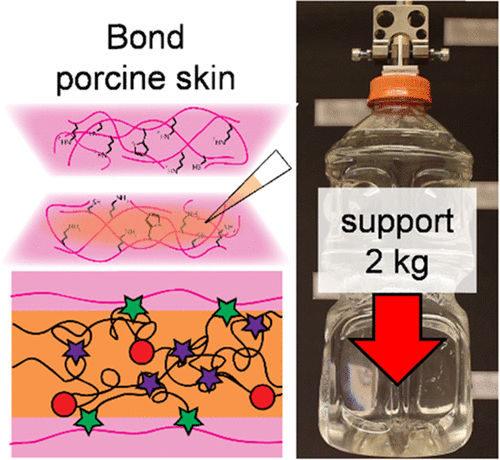当前位置:
X-MOL 学术
›
Biomacromolecules
›
论文详情
Our official English website, www.x-mol.net, welcomes your
feedback! (Note: you will need to create a separate account there.)
Catechol-Functionalized Elastin-like Polypeptides as Tissue Adhesives.
Biomacromolecules ( IF 5.5 ) Pub Date : 2020-06-01 , DOI: 10.1021/acs.biomac.0c00740 Malav S Desai 1, 2, 3 , Min Chen 4 , Farn Hing Julio Hong 1 , Ju Hun Lee 1, 3 , Yaojiong Wu 4 , Seung-Wuk Lee 1, 2, 3
Biomacromolecules ( IF 5.5 ) Pub Date : 2020-06-01 , DOI: 10.1021/acs.biomac.0c00740 Malav S Desai 1, 2, 3 , Min Chen 4 , Farn Hing Julio Hong 1 , Ju Hun Lee 1, 3 , Yaojiong Wu 4 , Seung-Wuk Lee 1, 2, 3
Affiliation

|
Adhesives can potentially be used to achieve fast and efficient wound closure; however, current products show poor bonding on wet surfaces, undergo swelling, and lack adequate biocompatibility. We designed a hydrogel adhesive with recombinant elastin-like polypeptides (ELPs), which are flexible proteins that can be customized for biomedical needs. The adhesive proteins are synthesized by chemically modifying the ELPs with dopamine, which contain adhesive catechol moieties. The resulting catechol-functional ELPs or Cat-ELPs can form flexible hydrogels that show stable swelling in aqueous conditions at 37 °C. We demonstrate their flexibility and viscoelastic properties through rheology. We also show the advantage of using customizable recombinant proteins to improve the material biological properties by demonstrating improved fibroblast binding on Cat-ELP by adding ELP with “RGD” peptides. We further confirmed in vivo biocompatibility and biodegradation of Cat-ELP hydrogels by implanting them in mice and monitoring for 10 weeks. Finally, we tested the bonding strength of the adhesives on porcine skin through tensile pull-off and lap-shear testing, in which we found strengths of 37 and 39 kPa, respectively. We demonstrated the tensile bonding strength by suspending a 2 kg mass on a one square inch (6.5 cm2) skin sample. As our adhesives are developed further, our strategy combining recombinant protein engineering and chemical modification will help yield an ideal bioadhesive for wound closure.
中文翻译:

邻苯二酚功能化的弹性蛋白样多肽作为组织粘合剂。
粘合剂可以潜在地用于实现快速有效的伤口闭合。但是,目前的产品在潮湿的表面上显示出较差的粘合性,会发生溶胀,并且缺乏足够的生物相容性。我们设计了一种具有重组弹性蛋白样多肽(ELP)的水凝胶粘合剂,重组弹性蛋白样多肽(ELP)是可以根据生物医学需求进行定制的灵活蛋白质。粘附蛋白是通过用多巴胺对ELP进行化学修饰而合成的,其中多巴胺含有邻苯二酚部分。所得的邻苯二酚官能ELP或Cat-ELP可以形成柔性水凝胶,在37°C的水性条件下显示稳定的溶胀。我们通过流变学证明了它们的柔韧性和粘弹性。我们还展示了使用可定制的重组蛋白来改善物质生物学特性的优势,方法是通过添加带有“ RGD”肽的ELP来证明在Cat-ELP上的成纤维细胞结合得到改善。我们进一步确认Cat-ELP水凝胶的体内生物相容性和生物降解性,方法是将其植入小鼠体内并监测10周。最后,我们通过拉伸剥离和搭接剪切测试来测试粘合剂在猪皮肤上的粘合强度,在该测试中,我们发现强度分别为37 kPa和39 kPa。我们通过在1平方英寸(6.5 cm 2)的皮肤样品上悬挂2千克的物质来证明其拉伸粘合强度。随着我们粘合剂的进一步发展,我们将重组蛋白工程和化学修饰相结合的策略将有助于产生理想的生物粘合剂来闭合伤口。
更新日期:2020-07-13
中文翻译:

邻苯二酚功能化的弹性蛋白样多肽作为组织粘合剂。
粘合剂可以潜在地用于实现快速有效的伤口闭合。但是,目前的产品在潮湿的表面上显示出较差的粘合性,会发生溶胀,并且缺乏足够的生物相容性。我们设计了一种具有重组弹性蛋白样多肽(ELP)的水凝胶粘合剂,重组弹性蛋白样多肽(ELP)是可以根据生物医学需求进行定制的灵活蛋白质。粘附蛋白是通过用多巴胺对ELP进行化学修饰而合成的,其中多巴胺含有邻苯二酚部分。所得的邻苯二酚官能ELP或Cat-ELP可以形成柔性水凝胶,在37°C的水性条件下显示稳定的溶胀。我们通过流变学证明了它们的柔韧性和粘弹性。我们还展示了使用可定制的重组蛋白来改善物质生物学特性的优势,方法是通过添加带有“ RGD”肽的ELP来证明在Cat-ELP上的成纤维细胞结合得到改善。我们进一步确认Cat-ELP水凝胶的体内生物相容性和生物降解性,方法是将其植入小鼠体内并监测10周。最后,我们通过拉伸剥离和搭接剪切测试来测试粘合剂在猪皮肤上的粘合强度,在该测试中,我们发现强度分别为37 kPa和39 kPa。我们通过在1平方英寸(6.5 cm 2)的皮肤样品上悬挂2千克的物质来证明其拉伸粘合强度。随着我们粘合剂的进一步发展,我们将重组蛋白工程和化学修饰相结合的策略将有助于产生理想的生物粘合剂来闭合伤口。











































 京公网安备 11010802027423号
京公网安备 11010802027423号